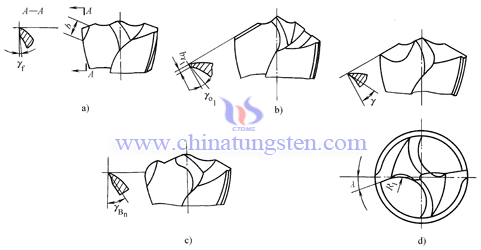Cemented Carbide Drills Grinding
The cemented carbide drills grinding ordinary drill additional sharpening different processing requirements of the chisel edge, the main blade, front and rear.Cemented carbide drills grinding improved twist drill structural defects, improved centering and cutting performance of core drilling site, significantly lower feed force, improve the quality of the drilling to extend the life of the drill bit. The carbide drill grinding can adapt to the specific material, the processing requirements of the particular shape of the parts, and can take advantage of the potential of the drill bit, to expand drilling process range, the effect is very significant, so a wide range of applications.
(1)Grinding chisel edge: the chisel the purpose of grinding is the premise to keep the drill tip strength, as much as possible to increase the drill tip portion of the anterior horn, shorten the length of the chisel edge to reduce the feed force, improve the drill tip centering capability. The preferred form, there are two.
1. Cruciform cemented carbide drills grinding: horizontal grinding out a cross, the same length, and the edge inclination remains zero, but significantly increases the chisel edge rake angle. This cemented carbide drill a grinding method is simple, jigs and fixtures drill grinding, adjusting a few parameters. However, the drill core strength is weakened, and wheel fillet radius smaller.
2. Within the straight edge cemented carbide drills bit grinding: the tip of the drill grind within the straight edge, both to shorten the length of the chisel edge rake angle increases again terrible at the same time increase the drill tip at the chip space. The form of this cemented carbide drill bit grinding drill tip strength, but also significantly reduce drilling feed force. Grinding wheel for grinding fillet without strict requirements, thus is widely promote the use of. Cemented carbide drills grinding parameters: bψ = (0.0 ~ 0.06) d, τ = 20 ° ~ 30 °, γτ = 0 ° ~ -15 °.
Such cemented carbide drill grinding requires manual operation in the form of some proficiency, because the cemented carbide drill grinding from the starting to the ending process, the relative position of the drill bit and the grinding wheel has been changes, reaches the end position in order to ensure above carbide drill grinding parameters. Jigs and fixtures grinding wheel fillet radius requirements to control and adjust the trajectory, so that when the end position is reached, the control parameter τ γτ.
(2)Grinding the main cutting edge : The purpose of grinding the main cutting edge is a change of the blade-shaped or angle, in order to increase the rake angle, control stars cuttings chip breaker. Or change the cutting load distribution, increasing the cooling conditions, increase bit life. There are three types of commonly used drill grinding form.
1. Grind concave arc edge. Strengthening drills centering effect help points crumbs off the crumbs. This carbide drill grinding form can also be used for irregular rough reaming. Grind concave arc depth is greater than the thickness of the workpiece when drill sheet can be formed into the outer edge nesting drilling, processing better.
2. Grind dual or multiple angles, or grind convex arc edge. Can be improved at the outer edge of the diamond blade cooling conditions, increase bit life. This form is suitable for drill brittle materials such as cast iron.
3. Grind points flute for easy chip removal. Sub-flute staggered the unilateral open or grind ladder edge. This form applies to moderate diameter drill cutting steel.
(3)Grinding front
Grinding front to change the distribution of the anterior horn, increase or decrease before the angle, or change the edge inclination in order to meet different processing requirements. Carbide drill bit grinding form as shown.
| Cemented Carbide Drills Grinding Form |
 |
Shown a grind at the outer edge chamfered front face. Reduce the rake angle, increasing the feed force, to avoid bar knife "phenomenon drilling. This form is suitable for the drill brass, plastic, bakelite. Chamfering the value of the front angle yf; front Sa copper ground into 5 ° ~ 10 °; drill bakelite ground to -5 ° to -10 °.
B is shown along the cutting sharpening chamfer, increased edge strength, suitable for a harder material. Or drill more toughness material, in order to increase the deformation, favorable chip breaking. The chamfers parameters: γo1 = 0 ° to 10 °, bγ1 = 0.2 ~~ 0.8mm.
c is shown in front, grind volume flutes increase the rake angle. This form is only suitable for cutting a soft material, such as Plexiglas. This can improve the quality of the machined surface.
dis shown in front, grind large rake angle and a positive cutting edge inclination angle, the control chip is discharged in the bottom of the hole direction. This is suitable for fine reamer.
(4)Grinding behind
Grinding behind the object without affecting the strength of the drill blade, to increase the rear angle, to increase the drill groove chip space, to improve the cooling effect.
Grinding blade (deputy edge behind) to reduce blade width, to grind vice after angle, to reduce the friction of the blade with hole wall. This form applies to the toughness, soft material finishing.
The form of grinding the carbide drill summarized above, practical often at the same time select two or three combinations.
Chinatungsten Online can provide various sizes and grades of cemented carbide cutting tools, non-standard products are also customized according to customer requirements. Welcome to consult and purchase sales@chinatungsten.com, sales@xiamentungsten.com .






 sales@chinatungsten.com
sales@chinatungsten.com